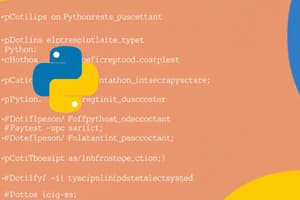Podcast
Questions and Answers
What is the purpose of the grade table in the program prompt?
What is the purpose of the grade table in the program prompt?
To assign a grade based on the user's input score.
How is the series sum calculated in the program?
How is the series sum calculated in the program?
By iterating through integers from 1 to n and adding the reciprocal of each number.
What is the correct syntax for printing 'Hello World' in Python?
What is the correct syntax for printing 'Hello World' in Python?
print('Hello World')
What are some of Python's built-in data types?
What are some of Python's built-in data types?
When do syntax errors occur in Python?
When do syntax errors occur in Python?
What is the difference between 'is' and '==' in Python?
What is the difference between 'is' and '==' in Python?
Name three of Python's standard libraries.
Name three of Python's standard libraries.
Explain the difference between mutable and immutable objects in Python.
Explain the difference between mutable and immutable objects in Python.
Study Notes
Python Engineering Question Paper: Focus on Python Basics
Python Syntax and Foundational Concepts
-
Correct Syntax for Printing "Hello World":
print("Hello World")Python's standard GUI library is Tkinter (not TensorFlow UserInterface).
-
Python Variables: Variables should not be reserved words, such as
printorlist. -
Data Structures: Python's built-in data types include lists, tuples, dictionaries, and sets.
Python Syntax Errors vs. Runtime Errors
Syntax errors occur during the compilation phase, while runtime errors occur during execution.
Python Libraries and Modules
-
Standard Library:
math,sys,random -
Most Popular Third-Party Libraries: NumPy, Pandas, Matplotlib
Basic Control Flow Statements
if,elif,elsefor,while,break,continue,pass,jump(gotois not supported).
Python Exceptions
ZeroDivisionError,EnvironmentError,BoundLocalErrortry,except,finally
Key Python Concepts
isvs.==: Theisoperator checks if variables are referencing the same object, while==checks if their values are equal.- Mutable vs. Immutable: An immutable object cannot be modified once created, while a mutable object can.
Python Data Manipulation Libraries
- NumPy for processing arrays
- Pandas for data analysis and statistics
Python Question Examples
- String Formats: Explain different string formats with examples.
- Input and Output: Write a program to take input from the user and print the sum of the series (1 + \frac{1}{2} + \frac{1}{3} + \ldots + \frac{1}{n}).
- Basic Control Flow: Write a program to prompt the user to enter a score and print a grade using the following table:
[ \begin{array}{c|c} \text{Score} & \text{Grade} \ \hline \geq 0.9 & A \ \geq 0.8 & B \ \geq 0.7 & C \ \geq 0.6 & D \ < 0.6 & F \end{array} ]
Python Data Engineering Questions
- Differentiate between distribution-based questions, data munging with Pandas, and data manipulation.
- Explain the advantages of NumPy and Pandas.
- Write code to solve a specific problem given a dataset.
Data Types and Operators
- Lists, tuples, dictionaries, sets
- Operators:
+,*,==,<,>,!=,<=,>=.
Python Core Competencies
To excel in a Python engineering interview, focus on Python fundamentals, theory, and practical uses, including Python definitions, Python theory, and writing Python functions. Practice questions from data engineering interviews, which often include beginner to intermediate Python coding exercises.
Studying That Suits You
Use AI to generate personalized quizzes and flashcards to suit your learning preferences.
Description
Test your knowledge of Python syntax, variables, data structures, control flow statements, exceptions, and key concepts like mutable vs. immutable objects. Explore questions related to Python libraries, control flow, data manipulation, and core competencies for Python engineering interviews.




